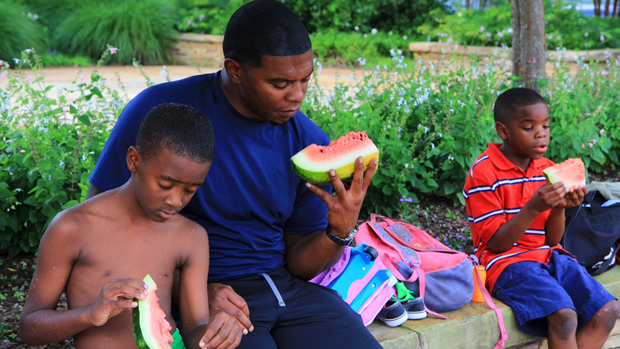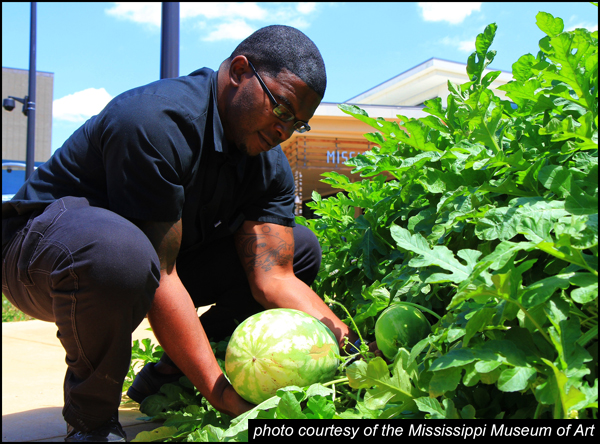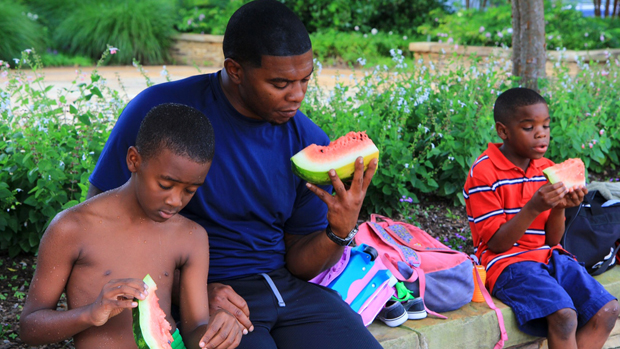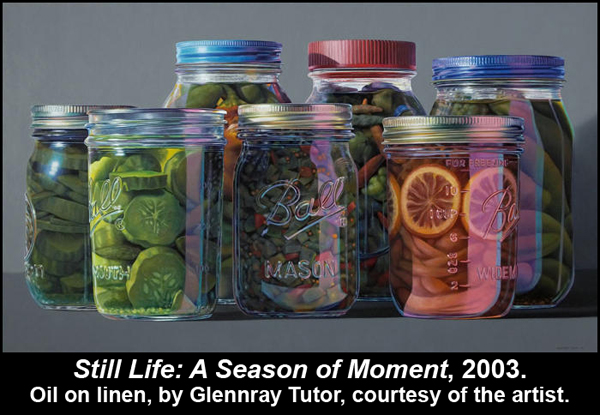
Jackson, Miss. (TLV) – In the restaurant and food world, “farm-to-table” has become a buzz-worthy catchphrase in the past few years. However, in Mississippi, an agriculture-based economy means farm-to-table is a time-honored tradition. In that respect, the popularity of notions like supporting local farmers, starting community gardens and knowing where our food comes from is really just a return to our roots.
 One Mississippi institution embracing the idea of providing greater access to freshly grown food product is the Mississippi Museum of Art in downtown Jackson. The Museum’s goal is to “engage Mississippians with visual art,” according to Marketing Director Julian Rankin. When the Museum learned about an available grant from Whole Foods Market’s Whole Cities Foundation to help children engage with fresh fruits and vegetables, it “seemed a perfect fit,” he continues.
One Mississippi institution embracing the idea of providing greater access to freshly grown food product is the Mississippi Museum of Art in downtown Jackson. The Museum’s goal is to “engage Mississippians with visual art,” according to Marketing Director Julian Rankin. When the Museum learned about an available grant from Whole Foods Market’s Whole Cities Foundation to help children engage with fresh fruits and vegetables, it “seemed a perfect fit,” he continues.
A key player in bringing together art and gardening is the Museum’s Executive Chef, Nick Wallace. Wallace grew up on a farm in Edwards, Mississippi, and from childhood, he “saw the impact of homesteading on a healthful lifestyle.” That early influence became evident as he honed his culinary chops throughout his career as a chef.
Before his current stint at the Museum of Art, Wallace served as the executive chef at the Hilton Garden Inn in downtown Jackson, where he oversaw construction of a large garden at the back of the property, along with a chef’s table where he created special dinners using house-grown produce. The garden there provided interactions with hotel guests, “to let them get their hands in [the dirt] and take fresh things home with them.”
 Wallace took his desire to get people eating freshly grown, healthful food even further when in 2012 he started a project at the Boys & Girls’ Club in Jackson called Club Organix. He envisioned the project as a way to “give kids a different mindset” about food that would translate into changing their whole family’s approach. During the afternoon, kids got a chance to work in gardens, and at night when their parents picked them up, Wallace gave a cooking demonstration using the fresh produce and handed out recipes for them to cook at home.
Wallace took his desire to get people eating freshly grown, healthful food even further when in 2012 he started a project at the Boys & Girls’ Club in Jackson called Club Organix. He envisioned the project as a way to “give kids a different mindset” about food that would translate into changing their whole family’s approach. During the afternoon, kids got a chance to work in gardens, and at night when their parents picked them up, Wallace gave a cooking demonstration using the fresh produce and handed out recipes for them to cook at home.
Now, thanks to the Whole Cities Foundation grant, Wallace can take that a step further and teach even more Mississippi children about growing and incorporating fresh foods into their lives. Wallace explains that currently, some 9500 schoolchildren from around the state visit the art museum annually, so the opportunity to touch a large number of young minds is—pardon the pun—ripe.
The project started last month with a build-out of raised gardens that kids will help tend during museum visits. In addition to gardens, children will receive activity books and seeds to take home. Wallace sees this as an important way to positively impact the health of the state; he says imparting a mindset of fresh food as the way to eat “changes up the parameters of our [state’s] future [health]” because “kids are the motivator” for family meal decisions. He goes on, “If instead of saying, ‘Mom, let’s go through the drive-through,’ a kid says, ‘Mom, let’s go to the farmers’ market,’ that will influence parents’ decisions.”
 As for how food fits in with the setting of the art museum, Wallace admits that while now he thinks “art is food, and it’s a perfect match,” it took him a little while to wrap his head around the idea. At first, it was with literal imagery: the museum’s photorealistic paintings of mason jars full of vegetable and fruit preserves by Oxford-based artist Glennray Tutor began to work their way into Wallace’s plating and presentation. He even incorporated one of Tutor’s paintings on his business cards. But as Wallace settled into his role at the Palette Café and catering museum functions, he began to find walks through the Mississippi Story gallery weaving their way through his creative thought process more and more. Now, he talks about plans to organize gallery talks with artists and himself and talk about how “the paintbrush is a knife.”
As for how food fits in with the setting of the art museum, Wallace admits that while now he thinks “art is food, and it’s a perfect match,” it took him a little while to wrap his head around the idea. At first, it was with literal imagery: the museum’s photorealistic paintings of mason jars full of vegetable and fruit preserves by Oxford-based artist Glennray Tutor began to work their way into Wallace’s plating and presentation. He even incorporated one of Tutor’s paintings on his business cards. But as Wallace settled into his role at the Palette Café and catering museum functions, he began to find walks through the Mississippi Story gallery weaving their way through his creative thought process more and more. Now, he talks about plans to organize gallery talks with artists and himself and talk about how “the paintbrush is a knife.”
He also started thinking about food, and the experience of growing and preserving, as art, as did the entire museum staff. Adds Rankin, “Even before the Whole Cities grant, Nick started planting edible flowers in the Art Garden; the large plantings the Whole Cities grant will enable is an extension of these growing artworks—they’re edible, yes, but are also beautiful, living pieces.”
Merging fresh food and art will continue to evolve as school groups pass through and staff and visitors collaborate. There also may be some truly organic growth of programming. As an example, both Wallace and Rankin point to a happy accident that became a favorite fresh food experience. Some time ago, an event at the museum evidently served watermelon, and some seeds that were spit out took root without anyone’s knowledge. In time, the staff discovered an unplanned watermelon patch, which they were able to use as schoolchildren made use of the Museum’s classroom space—while on their breaks, the kids picked and enjoyed eating the fresh fruit.
Remaining open to opportunities that present themselves like that one and the Whole Cities Foundation grant will surely result in a more full experience for visitors to the museum for years to come.
The Mississippi Museum of Art is located at 380 South Lamar Street, Jackson, Mississippi and is open Tuesday through Saturday 10 am–5 pm, Sunday noon–5 pm. Visit msmuseumart.org for more information. ![]()
–
This article was originally printed in The Local Voice #224 (published March 5, 2015.)
To download a PDF of this issue, click here.


